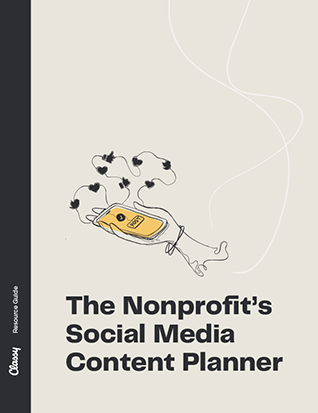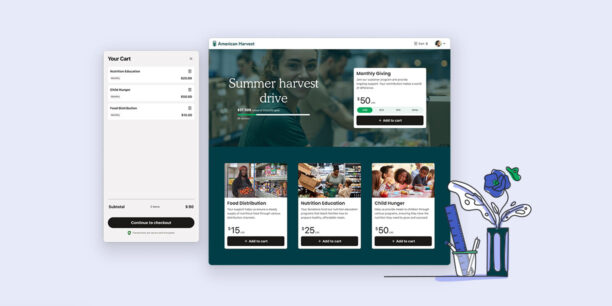Blogging for Nonprofits: Tips From Content Professionals

Request a Demo
Learn how top nonprofits use Classy to power their fundraising.
Years before podcasts were the hot trend in content creation, blogging was the platform of choice for digital marketers. Blogging might sound technical or complicated, but it’s as simple as posting valuable content to your organization’s website.
Nonprofits can use blogs just as easily and effectively as any other business. Seventy-nine percent of marketers name blogging as their most effective strategy for content marketing, and 92% of nonprofit professionals use content marketing, which includes efforts like blogging, podcasting, and creating video content.
To support nonprofits with their blogging efforts, two of Classy’s own content marketing experts—Jess Woloszyn and Hannah Durbin share some tips from years of writing.

Is Blogging Still Relevant For Nonprofits?
Blogging can be an effective marketing initiative for any organization if you’re willing to dedicate the time and resources.
There’s so much you can use a blog for. From informing donors on what’s happening within your organization to providing educational resources for supporters to make the most of peer-to-peer campaigns you host.
A blog provides value because of its versatility and flexibility. There’s no limit to the type of content you can share. Meanwhile, a consistent blog builds SEO credibility for your website, while also building brand visibility and thought leadership.
A strong blog not only increases brand awareness but also helps your organization establish credibility and trust. It allows you to become a thought leader in your space, leaving the impression that you are an ‘expert’ within your field and a reliable source of information people can turn to.
How Can Nonprofits Get Started With Blogging?
Now your organization is ready to start a blog (or perhaps improve your existing blog). But perhaps you’re not sure how to get started. Our experts shared their perspectives.
Jess Woloszyn offers these three blogging for nonprofits tips:
- Develop a peer editing system to get multiple perspectives involved. Maybe a team member in marketing, a top fundraiser, or a family member who can offer an unbiased perspective.
- Your blog posts don’t need to be long to be effective. Break content up with headers into clear sections. These help readers skim and find the information they want.
- Lean into visuals when you can. They make blog posts more engaging and support the points you’re trying to make in text.
Hannah Durbin added four nonprofit blogging suggestions:
- Cut the fluff and keep your language casual. Write like you’re explaining something to a friend over a cup of coffee.
- Do your research. See what topics are trending. Ask what people are interested in. Provide answers to the questions your audience is asking.
- Educate yourself on SEO best practices. Take advantage of keywords to elevate your posts and help them get found online.
- Don’t rush the process. Step away from the post a few times before publishing. A fresh mind does the best work!
Where Can Nonprofits Look for Blog Topics?
Finding an idea to center your blog post around can be a challenge for nonprofits. The sources of inspiration and ideas are endless, but where are the most effective places to look?
- Collect commonly asked questions about your cause or from your donors as a repository of topics that you already know are going to resonate
- Read other organization’s blogs for inspiration. Subscribe to other popular blogs you find interesting. Take note of their headlines.
- Do a Google search for some keywords related to your organization—like ‘food pantry’ or ‘animal shelter.’Review the pages in the results. You can also refer to Google’s ‘People Also Ask’ to generate some ideas.
How Frequently Should Nonprofits Blog?
More blog posts isn’t necessarily better. In fact, if you write too many posts on the same topic you can actually cannibalize your search results. Focus on creating high-quality posts around topics you know people are searching for and that resonate with your audience.
If you’re just starting your blog, set a realistic goal for the size of your team. For example, two posts every week if you have a few team members. Or one post every week if it’s only you. As you establish your rhythm, increase your cadence. It’s better to be consistent than initially taking on too much and then quitting.
If you set up cadences around blog post releases, you can keep people coming back to check for new content. You give yourself a way to engage donors weekly, bi-weekly, or monthly as you put out new content to share.
Hannah agrees with the value of consistently publishing blog content, but also points out the opportunity to gather more data from your audience.
A consistent posting calendar keeps your content top-of-mind for readers. Regular blogging increases brand loyalty and allows your nonprofit to start collecting more accurate metrics.
More blog posts means more opportunities to see what content resonates and what doesn’t. Test out content on your blog and reshare the most effective content on other marketing platforms.
How Can Nonprofits Find the Time to Blog?
Lean into repurposing content you’ve written for grant proposals, award applications, or your own website and expand from there. You could collect stories from your donors or audience to share. This is also a good engine for providing content for your other marketing platforms.
Editing takes time, but online tools like that make it much easier to get back those hours. Use tools like Grammarly to avoid having to make it perfect. Block time weekly to blogging so it becomes a regular part of your day.
Share the work as much as possible. Ask your team or volunteers to help out. See if any organizational partners or sponsors want to write guest blog posts for you. Don’t try to take on all the work yourself.
What Elements Make an Effective Blog Post?
The perfect blog post completely depends on the topic, but typically an effective post will have at least a few of the following elements:
- Visual elements like images, GIFs, and videos
- Headings that are clear and offer value
- Links to other relevant content—either from your website or external sites
- An action step a reader can take
- Consistent brand tone across all content
Read blogs from other organizations and brands to see what their posts contain. Learn from the practice of others to make your content even better. The more blog posts you read and write, the easier the process will become.
How Should Nonprofits Measure Blogging Success?
Blogging success will look different for each organization. Goals for a blog can be traffic-driven, with the desire to get as many new people to the site as possible. A blog can also be more conversion-driven with a greater focus on getting site visitors to convert via a form field.
Depending on your organization’s goals, here are a few metrics to consider:
- Sessions: Google Analytics helps you see how many sessions your posts have in a given time period. Sessions are typically better indicators of how many people are coming to your site because unlike pageviews, sessions look at the number of people who landed on a page of your site.
- Rankings: Rankings in search results can help you drive significant traffic to your site. By understanding what positions your posts are ranking, you can evaluate the success of your blog content.
- Conversions: Through Google Analytics you can also evaluate your conversions, whether that’s a guide download or a form fill to contact sales.
Set Your Benchmarks: Set benchmarks each month based on your results, then determine which posts are successful by how far they can exceed those results.
If something isn’t performing well, revamp it! Don’t delete good work. Keep working until you get it right and it performs well with your audience.
Ready, Set, Blog
Marketing trends come and go, but blogging remains a steady option for content marketers. The medium has certainly evolved over the years—adding more multimedia options like embedded images and video. This only makes it a more valuable resource for nonprofits.
Blogging is a relatively low-cost marketing resource, especially since organizations are able to repurpose content that you’re already sharing elsewhere. But it still takes time to get it right. Take the time to build a strategy to get the most potential out of your nonprofit’s blog.
If your nonprofit isn’t already blogging, consider starting small and seeing what impact it makes. As you expand your efforts, you’ll likely begin to see a return. Read some of the latest blog posts from Jess and Hannah for good examples of what blog posts should look like:

Promote Your Blog on Social
Subscribe to the Classy Blog
Get the latest fundraising tips, trends, and ideas in your inbox.
Thank you for subscribing
You signed up for emails from Classy
Request a Demo
Learn how top nonprofits use Classy to power their fundraising.
 Explore Classy.org
Explore Classy.org 

